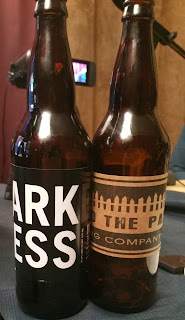I am writing to you from 36,000 feet in the air, on the long road home from San Francisco to Ottawa, with a brief layover in Toronto. During my stay, which was my quarterly jaunt across the country for my day job, I had the opportunity to log some time at the Mikkeller Bar (Untappd being my punch-card) just around the corner from my hotel. I had been there once before for a couple of beers in mid-June, but this time around I was able to get down to business. This is my account of two very foggy evenings.
The first session we had was held below the main bar in the Tivoli sour room(!!!). Needless to say I was pretty thrilled. To make matters even better, they had a Brett IPA named “Mastodon Mother Puncher”. As a big fan of Mastodon who has seen them a few times, I may have been a bit giddy. The brew was well balanced, the hop bitterness taking away most of the gnarly horse blanket flavour associated with Brettanomyces that some people appreciate. Having grown up in a rural town with plenty of farms, I’ve had my share of horse stank.
Deciding to ride the sour train throughout the night, I then moved on to the various sour beers that leverage spontaneous fermentation: Spontanyuzu, Spontandryhop Centennial, and Spontandryhop Mosaic. These exquisite brews had the same great balance of sweet, bitter, and tart that I have come to expect from Mikkeller beers. The Japanese Yuzu fruit adds a juicy element to the tart brew, the centennial dry-hopped version added a floral element to it - predominantly on the nose, and the Mosaic iteration contained elements of tropical fruit to accent the sour goodness.
| Mikkeller Oude Gueuze |
Let’s fast-forward a few rounds to the main event: a bottle of Oude Geueze collaboratively brewed by Mikkeller and Belgian brewers Brouwerij Boon. This blend of Lambics ranging from one to three years old was amazing. Shared amongst myself and four other beer geeks, the Oude Geueuze was a huge hit. Dry, with an almost sparkling wine-like effervescence, this beer went down super well, with the sour aftertaste I have come to know and love. And while there was definitely some essence of horse blanket from the wild yeast (aka Brettanomyces), it wasn't prevalent.
That pretty much wraps up night one. Beer aside, though, one of the coolest elements of travel for me is meeting other Canadians, especially those who are familiar with the small town from where I emerged. The bartender - who took great care of us in the Tivoli room - was from Toronto, and was familiar with my neck of the woods, which is cool. Trashed and probably incoherent as I was, it was still fun to chew the fat for a bit and find a familiar element in an unfamiliar place. While not as serendipitous as meeting a dude from Ottawa in a Singaporean brew pub, it’s still noteworthy.
| The lovely Jackie Brown. |
For Mikkeller part deux, I didn't jump into the sour beers immediately, deciding to wade in slowly. Instead, I started out with “M is for Murker”, a wet-hopped New England-style IPA that was actually quite mellow. I suppose that's the nature of wet-hopping, though. The beer was still packed with floral, melony flavour, and I do like the hazy, golden hue. I had a few other beers after the Murker, but the one that really stood out was Jackie Brown. Holy shit. Honey, caramel, and some nuts on the palate, balanced out with some floral/earthy hops in Simcoe, Nugget, and Centennial, this brew rocked my world.
After I had my rendez-vous with Jackie, it was near time to wrap things up so I would be able to function for the flight home, so I only had two more to wrap up the night: another Spontandryhop Mosaic and one more Mother Puncher to round things out. What a great way to end the night, and the trip as a whole. Between the excellent beers, the welcoming atmosphere, the phenomenal service, and hanging out with great people… hot damn, those were two good nights. See you in March, Mikkeller.
